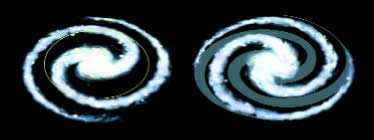|
|
|
|
|
|
|
|

|
|||||||
 |
| Motion | Pages 34-35 | See Linked Version | |
Earth's atmosphere rotates in this way because it is not solidly connected to the surface of the planet. This sets up patterns of high-altitude winds that drive weather systems in certain directions. Over the United States, those winds usually blow from west to east, allowing us to track storms as they move across the country. Other parts of the globe see winds in the opposite direction or, near the equator, meandering breezes known as the doldrums. Another consequence of combined motion and rotation affects our lives dramatically on Earth and creates striking patterns on other worlds. We call it the Coriolis effect: an apparent deflection in the paths of moving objects caused by Earth's faster speed near the equator than near the poles (pages 32-33). Low-pressure systems in the Northern Hemisphere--including hurricanes and tornadoes--tend to rotate counterclockwise as a result of these deflections. In the Southern Hemisphere the patterns are reversed. According to urban legend, the Coriolis effect compels water to drain from tubs and toilets either clockwise or counterclockwise in each hemisphere. That's a fun myth, but it's not true. The direction that water flows out of a basin is determined almost entirely by the basin's shape and random currents in the water. You'd see evidence of the Coriolis effect only if the basin was many miles across and totally still when you pulled the plug. The Coriolis effect has the same result as a sideways push on a moving object. At its strongest on Earth's surface, the force is just one three-hundredth as strong as the planet's gravitational pull. A football kicked 50 yards either due north or south would move sideways about half an inch thanks to this effect--probably not enough to change the outcome of a game. But when something travels many miles, the effect becomes substantial. In an undistinguished moment in the history of warfare, British naval forces forgot to adjust for the reversed direction of the Coriolis effect in the Southern Hemisphere when they clashed with German warships near South America during World War I. As a result, about a thousand missiles missed their targets and fell into the ocean.
We might like to attribute the lovely spirals of rotating galaxies to the Coriolis effect as well. However, the physical processes are very different. Spiral arms probably arise from shock fronts called "density waves" that ripple through the gas in a galaxy. When stars and gas encounter these waves, they move more slowly than they do in the rest of the spinning galaxy. This piles them up in galactic traffic jams that generate bursts of newly formed stars within the gas clouds. We see the denser concentrations of stars as spiral arms. Cars moving on a congested highway clump together in a similar way. Dense knots of traffic form as the speeds of vehicles vary. A single slow-moving truck (right) can have a ripple effect, forcing vehicles to slow down and speed up in frustrating bursts for miles behind. These knots gradually creep along the road. The knots themselves may persist for a long time, even though individual cars get stuck in them for only a few minutes. The force that dictates the shapes of those spiral arms is gravity--the same force that holds you in your chair as you read this page. We owe our initial understanding of gravity to Isaac Newton. His three laws of motion alone would have guaranteed his (continued) Of Spiral Arms and Traffic Jams Spiral galaxies may resemble terrestrial hurricanes, but the forces that create their distinctive spiral arms are quite different. Indeed, the differential rotation that produces the Coriolis effect (and hurricanes) should eventually disperse any spiral structure that might form in a galaxy. One mechanism to explain how spiral arms persist is a spiral-shaped density wave that moves through the galactic disk more slowly than the orbiting stars, dust, and gas. As gas and dust get caught in the galactic traffic jam, the congestion triggers a burst of star formation that lights up the spiral pattern for a time (below). Then, like the knot of cars that repeatedly bunch up around a slow-moving truck (right), the density wave moves on. 
Density Waves When orbiting gas and dust (yellow circle, above left) intersect a spiral density wave, the resulting burst of new star formation lights up the spiral. Because of differential rotation, older stars move ahead of the density wave, creating the trailing arms. As older stars die, the original pattern smears out. Millions of years later, the density wave has rotated, the new spiral arms are lit by different stars, and the old arms fade away (above right). |